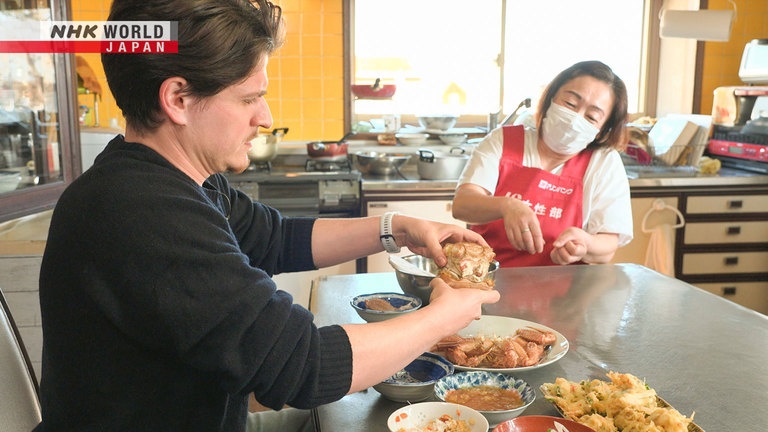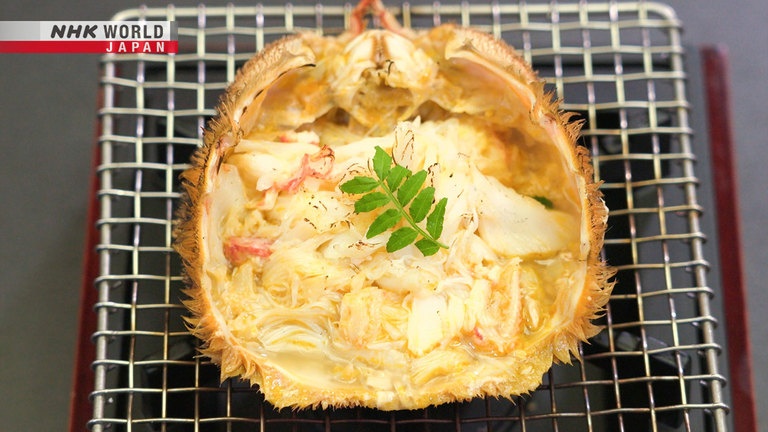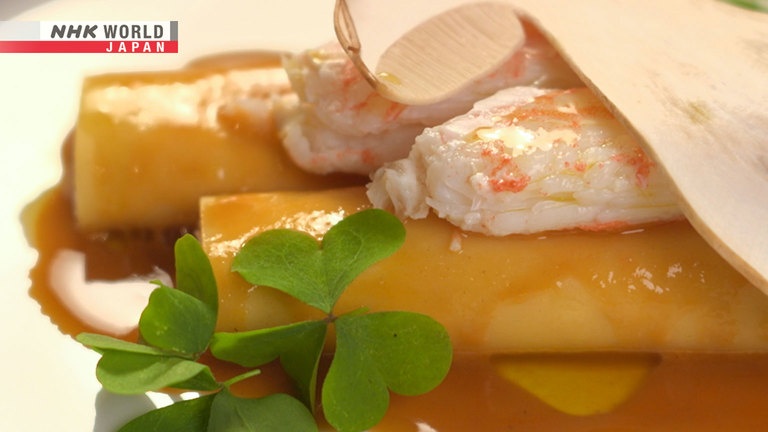HORSEHAIR CRAB
Horsehair crabs — the ones covered with tiny hairs. The high-end crustacean is loved for its sweet, delicate meat and rich and creamy innards, or kani miso. At one of the world's largest wholesale markets, an expert shows us what to look out for in terms of quality. Also join cage fishers in Hokkaido Prefecture during chilly morning hours. After the treasure hunt at the sea, taste the prized horsehair crab in local dishes, and venture back to Tokyo to see how it's used in international cuisine. (Reporter: Kyle Card)




Transcript
Tokyo: this world-class metropolis is a veritable gourmet wonderland.
Discover the stories behind the ingredients that make this city so delicious - so "oishii."
Today we focus on a hairy crustacean, the horsehair crab.
It's one of the most popular of Japan's high-end seafood ingredients.
Its delicate meat is packed with sweetness, and the rich and creamy innards, called kani miso, are a real treat.
Very tasty.
Japan eats a lot of crab.
But horsehair crabs, found around northern Japan, are at the top of the favorite list.
They can be cooked in many ways to liven up just about any feast.
And not just for Japanese food - horsehair crab is used in all types of cuisine.
In crab-loving Japan, see what makes this hairy little guy so unforgettable.
Trails to Oishii Tokyo.
Good morning, everyone.
My name is Kyle Card and I come from Canada.
Now, in Canada, we love eating crab, but that love pales in comparison to that of the Japanese people.
So today we're going to explore a very popular type of crab here in Japan, the horsehair crab.
I'm very curious to find out what kind of crab it is and what makes it so beloved to the Japanese people.
Why don't we find out together?
Kyle begins at a wholesale market in Toyosu, one of the largest in the world.
It's home to around 500 seafood wholesalers.
Buyers flock here every morning to get fresh seafood.
With over 600 types of seafood from all over Japan, you could call it... Tokyo's Pantry.
Check it out.
I found some crabs.
Look at the size of that one!
- What kind of crab is that?
- King crab.
This wholesaler's been around since 1889.
They trade all kinds of crabs.
Sakai Mamoru is a veteran with over 40 years of experience.
- Do you have horsehair crabs?
- Here!
Is that it? It's really hairy.
Right.
Cool.
Little hairs cover the whole crab.
They apparently detect water flow and offer protection against natural predators like octopuses.
- Touch it.
- May I?
It's kind of soft. Furry.
It's prickly and furry at the same time.
Look at these furry legs.
Quite cute.
How interesting.
I know the Japanese love crab.
Is this popular too?
It's in the top 2, for sure.
It has tasty innards,
called kani miso.
The meat is good too, of course.
With sweet meat and good kani miso,
it's the best crab in my opinion.
- That sounds amazing.
- It is.
Do you farm these?
We can't. Raising them takes years
and costs too much money.
These are all natural.
Horsehair crabs are found along the Pacific coast from Japan to Alaska.
They live on sandy and muddy seabeds over 150 meters deep, in temperatures below 15 degrees Celsius.
They're mainly caught around Hokkaido.
Fishing seasons are set by area to ensure a stable year-round supply.
How do you know which one is good?
Dirty shells are a clue.
This has barnacles on it.
This one is quite clean.
So, this one here is tastier.
Why is that exactly?
Dirty ones haven't shed for a while.
This one has a lot of barnacles,
so it hasn't shed for about half a year.
- That means it's packed with meat.
- Interesting.
Horsehair crabs shed their shells periodically over one to two years, in a process called molting.
After molting, the crab has more room to grow in its new shell.
At this stage, the meat soaks up too much water when cooked, and loses flavor.
How much for one?
- This is about 10,000 yen.
- That much?
This one is about 7,000.
Kyle visited in November, said to be the most expensive month due to a lower catch volume.
Horsehair crab consumption hasn't been a thing for very long.
In the past, they were mostly a nuisance, always getting caught in fishing nets that weren't meant for them.
Then about 70 years ago, fishers in Hokkaido boiled some to be sold at Oshamambe Station in place of ekiben boxed lunches.
They were a hit, and word of their tastiness spread across the country.
They were much more affordable at the time.
Kyle heads to Hokkaido-home of the horsehair crab.
It's a one-hour and 40-minute flight from Tokyo.
He arrives in Kushiro, a port town on the Pacific coast.
He'll eat horsehair crab at a local restaurant.
The chef is busy prepping the day's catch.
Tosaka Yasuhiro is the third-generation owner.
He'll make sashimi first.
Leg meat is soaked in ice water for a few minutes to make it firm.
Thank you for waiting.
Horsehair crab sashimi.
A wonderful spread of horsehair crab sashimi.
Something that can only be enjoyed fresh.
Kyle dips a piece in soy sauce.
Pull it.
That's it.
So tender.
And quite sweet.
- Is that because it's fresh?
- Yes.
With horsehair crab, simple is best.
The flavor is good as-is.
Next up is shabu-shabu.
Crab meat is dipped in boiling kelp broth.
There wasn't any red
meat in the sashimi dish.
That part contains umami,
but it can't be eaten raw.
It's the meat inside the
thinner part of the shell.
It needs to be cooked a bit.
So it's perfect for shabu-shabu.
The meat puffed up a bit.
I can't wait.
He dips it in a tart ponzu soy sauce.
Definitely more umami.
The sweetness comes out more too.
- The flavors are enhanced.
- A nice upgrade.
- You haven't tried kani miso yet.
- Right, the innards!
It's what people love the most
about the horsehair crab.
Here's a great way to enjoy kani miso.
Crab meat and innards are grilled in the shell.
There's kani miso underneath.
Mix it with the meat and enjoy.
It smells like the ocean.
- This yellow soup has kani miso?
- Yes.
- Great umami.
- Right.
It's just such a strong concentration of that crab flavor, and that miso just really brings out the umami and the sweetness of the meat.
And the subtle saltiness-the little briny kick it's got there, wonderful.
Kyle also gets crab sushi.
The meat has mouth-watering sweetness, and the kani miso is super rich.
Horsehair crab is truly amazing.
Kyle's next stop is Shiranuka, 30 kilometers west of Kushiro.
The Shiranuka Fishing Cooperative, which is allowed to fish from September to January, is responsible for Hokkaido's largest haul of horsehair crab each year.
Kyle meets with fishers at a port in the middle of the night.
- Good morning.
- Morning.
He gets permission to tag along.
Yamada Akira is the ring leader.
His crew of seven rides for an hour out to the fishing grounds.
These are the cages they use.
Squid and other bait are placed in black containers, and the cages are submerged for 24 hours.
Horsehair crabs live on seabeds 100 meters deep.
One hundred cages are placed at seven locations.
The day's low is minus four degrees Celsius.
A chilly breeze awaits at the first location.
Alright, so we've arrived at the first buoy.
They just bringing up the traps now.
So I can't wait to see.
We're gonna get some crabs.
Alright.
There's the first one.
We got some from the cage.
Once the cages are up, sorting begins.
They only collect crabs with a shell length of nine centimeters or more.
They're quickly measured with a special tool and sorted in containers by size.
Those under nine centimeters will be returned to sea.
This is a standard set by the cooperative to conserve resources.
- Ah, eggs.
- Is that bad?
- Can't catch females.
Females are also spared.
Gender is determined by the belly shape.
Fishers can spot subtle differences quickly.
Well, it looks like they didn't pass the audition.
Very strict.
So you get about, like, hundreds of different crabs and maybe only a few you can take that are actually sellable.
This explains why horsehair crabs are so expensive.
Cages are collected in droves, in the freezing cold.
The work is made harder by rough waters.
But they're very efficient.
Fishers prepare for the next stop while the cages are dealt with.
Alright, so right after they pull up the traps, they're rebaiting them right away.
So they'll just put them right back in the water after we're done with this location.
It's quite efficient actually.
Pull it up, pull out the crabs, put the bait back in, put it aside, throw it back in the ocean afterwards.
It's just very systemized.
How do you locate crabs?
We judge their location based on
the water temperature and current.
Also, if we pull up a lot of small crabs,
that means there are big ones further out.
Things like that.
The water temperature drops dramatically in November.
During this time, crabs move in search of more comfortable waters.
Determining their location is always tricky for fishers.
But experience and intuition are the key to their success.
Pulling up all 700 cages takes six hours.
Once the emptied cages are released at new spots, their work at sea is done.
Back at the port, the crabs are unloaded quickly and hauled to a cargo site, where cooperative staff and local buyers await.
Up to 3,000 crabs can be caught in a day, but they only got about 100 this time.
It's a massive hunt for a light, precious haul.
They're weighed and quickly presented to buyers.
The buyers are strict too.
They check the size, for damaged legs and other things.
The chosen ones are sent to Tokyo and other cities around Japan the same day.
They also ship out horsehair crabs that have been boiled in salt.
They're chilled or frozen, packed, and shipped across the country.
- Hello.
- Come in.
Kyle visits a fisher's home.
Kato Miki leads a group of fisher wives.
She's ready to cook up some local cuisine.
She gets right to it, using her hands and scissors to prep a crab.
The pieces are put in boiling water.
The shells with kani miso inside are also used.
She boils them for about ten minutes, removing scum periodically.
She then adds a scoop of miso paste.
Hearty horsehair crab miso soup.
It's served with horsehair crab rice!
Rice is cooked with shredded crab meat, carrots and fried tofu, and seasoned with soy sauce, mirin and sake.
Kyle begins with the miso soup.
The umami of the crab just goes so well with the saltiness and of course the umami of the miso as well.
"Oishii!"
Now the meat?
- Use your hands.
- Got it.
It's full of meat.
So good.
How is it so sweet?
Amazing.
Now for the rice.
The crab flavor comes out
as soon as you take a bite.
It's great with rice. Nice!
Horsehair crab from Shiranuka is
especially firm and sweet.
The fishers work hard to get the best ones.
Kato recommends boiling a whole crab in salt water.
That way, you can savor its full flavor.
Keep the shell on the bottom so that
the kani miso doesn't fall out.
Look at all of that miso.
Put the miso on top of shredded crab meat.
- Like this?
- Yep.
Itadakimasu.
Richer, with more umami.
Saltier too.
A great balance of flavors.
This is hard to stop eating.
Kato's husband and son are fishers too.
Fishers set out early in the morning.
Once false move could send them
flying into the water.
They put themselves in danger
to bring us wonderful crabs.
There's a romance to it.
It felt like we were hunting treasure.
Horsehair crab - the treasure of the Hokkaido seas.
I could taste the love and determination of local fishers in Ms. Kato's wonderful food.
Back in Tokyo, Kyle heads to Kita-Aoyama.
He'll meet a chef who always receives high ratings in gourmet guidebooks.
Honda Tetsuya opened this restaurant in 2004 after training in Italy.
His food has Japanese and French elements, prepared with Italian finesse.
The first dish.
Edible flowers add color to cauliflower foam.
Below that is horsehair crab meat mixed with olive oil, lemon juice, and kani miso.
- Itadakimasu.
- Enjoy.
So much crab in there, wow.
Lavish.
- "Oishii."
- Thank you.
- The creamy cauliflower
brings out the crab's flavor.
- Right.
The kani miso makes it thick and rich.
And salty caviar enhances the crab umami.
How did you come up with this dish?
The Japanese like crab in creamy textures.
Crab cream croquettes are a good example.
I wanted to make something lighter
while bringing out the crab's flavor more.
I use cauliflower when it's in season.
I see.
He mixes crab meat with porcini mushrooms, ricotta cheese, roasted potatoes, and sauteed onions.
This is formed into cylindrical shapes and rolled in pasta dough.
Thanks for waiting.
It looks cute.
The cannelloni is topped with a big porcini mushroom slice and some horsehair crab meat.
It is a festival of crab in your mouth.
It is so flavorful and aromatic and the crab umami is just like, oh!
- Very savory.
- Right.
That's the sauce.
It's sauce americaine made with stir-fried shells.
That's why the crab flavor is so pronounced.
Right. There's a fried aroma.
Very tasty.
It makes the crab meat sweeter too.
"Oishii."
What makes the horsehair crab special?
The meat's delicate, but has
strong sweetness and umami.
Call it the queen of crabs.
It's an indispensable Japanese ingredient.
Fishers head to the seabeds of Hokkaido on a treasure hunt for horsehair crab.
Chowing down on the queen of crabs?
Now that's something for the bucket list!
In Tokyo, every ingredient has its own story.